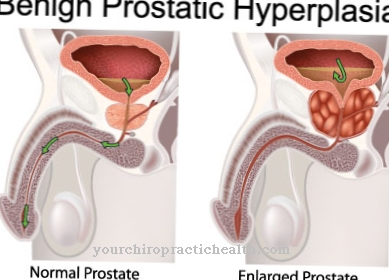The Left ventricular hypertrophy describes the tissue enlargement of the left myocardium (heart muscle) of the left heart ventricle. The medical term hypertrophy stands for tissue enlargement. The two heart cavities of the human heart located between the pocket valves and the leaflet valves are called the heart ventricle. The opposite of left heart hypertrophy is right heart hypertrophy, which affects the right myocardium of the right heart ventricle.
What is left ventricular hypertrophy?

© peterjunaidy– stock.adobe.com
Is a synonym left ventricular hypertrophy. People with cardiac hypertrophy have a thickened heart muscle, either on the left or right side, depending on the condition. Left ventricular hypertrophy means an increasing heart muscle mass. The muscle fibers thicken and the cells enlarge.
The process of muscle gain is quite desirable in other areas of the body, for example when people do certain sports that build muscle mass. Most people associate something positive with an increase in muscle mass, but this increase is life-threatening in the heart area. In this area, a distinction must be made between the desired, physiological cardiac muscle hypertrophy of athletes (sports heart) and the cardiac muscle hypertrophy due to the continuous application of pressure, which ultimately takes a pathological course.
causes
It is an adaptation mechanism with which the heart adapts to the changed starting position due to the increased and chronic overload of the heart muscle in the left ventricle. Triggers can be hemodynamic or non-hemodynamic processes. Possible causes include arterial hypertension (high blood pressure), hypertrophic cardiomyopathy, or a heart valve defect.
Storage diseases such as Fabry's disease rarely occur in this context. The most common cause of myocardial hypertrophy is constant pressure on the heart muscle from high blood pressure. Left ventricular hypertrophy leads to an obstruction of blood from the left ventricle due to aortic valve stenosis (narrowed heart valve). The pressure on the ventricle wall increases. The heart uses a “ruse” and tries to compensate for this undesirable process in the form of increased stress caused by muscle growth.
Cardiac hypertrophy caused by exercise, on the other hand, is a desirable phenomenon that is physiologically different from the pathological process in terms of its reversibility (ability to regress) and structure. Left ventricular hypertrophy appears more often than right ventricular hypertrophy. This means that the left ventricle is affected more often than the right ventricle.
Heart medicine differentiates between the concentric (Myocardial hypertrophy) and the eccentric Cardiac muscle hypertrophy.- The concentric shape muscle growth is caused by pressure on the heart. The volume of the affected ventricle is small, and the heart muscle walls are thickened. Under normal circumstances, the heart walls are compliant. This resilience diminishes during the filling phase, which builds up muscle tissue. Fiber tissue is deposited in the muscles.
- The eccentric shape of the heart muscle growth is caused by volume loading of the heart chamber. This is caused, for example, by insufficiency of the aortic valve (leaky aortic valve). A more or less developed part of the blood in the systole (tension phase), which is normally ejected into the large body artery, rushes back into the heart chamber during the relaxation and filling phase (diastole).
The blood volume is increased by this process, which leads to cardiac muscle hypertrophy, or ventricular dilation. The left ventricle is hypertrophied more often than the right. The latter is particularly affected by high pressure in the pulmonary vessels. Hereditary forms of this disease such as hypertrophic cardiomyopathy are rare.
Symptoms, ailments & signs
As the muscle tissue increases, the left ventricle stiffens due to the accumulation of non-muscular fiber tissue that accumulates in the muscle fibers. This results in a reduced elasticity of the heart chamber, which is also known as diastolic dysfunction. The main symptom is shortness of breath when the patient is exposed to physical activity.
It is a heart failure in which the systolic pump function and the size of the heart are preserved. If the heart size increases by more than 500 grams due to muscle growth, there is a disproportion between the oxygen demand of the heart muscle and the actual oxygen supply.
The capillary blood system supplies the heart muscle with oxygen, but in view of the muscle growth it reaches its limits because the organ is growing too fast or the blood vessels are changing in places due to calcification (ateriosclerosis). The consequences are chest pain (angina pectoris), heart muscle disorders, heart attack and heart failure.
Diagnosis & course of disease
Heart mass increases with age, even in healthy people. This normal increase in mass occurs due to an increasing wall thickness of the left-hand heart ventricle. At the same time, the elasticity of the heart muscle decreases. As a result, blood pressure increases both in retirement and during exercise. These symptoms lead to a diagnosis using an ultrasound scan of the heart called echography. Magnetic resonance tomography (MRI) provides further clinical findings.
Complications
In the worst case scenario, left ventricular hypertrophy can lead to patient death. Because of this, this condition must definitely be diagnosed and treated by a doctor. Various consequential damages and other complications can thus be avoided. As a rule, those affected suffer from shortness of breath, which is associated with the patient's reduced resilience.
It is not uncommon for severe fatigue to occur and those affected no longer actively participate in everyday life. Furthermore, severe physical stress is usually no longer possible for the person concerned or is associated with a great deal of exertion. It is not uncommon for chest pain to occur. In the worst case, the affected person suffers a heart attack and dies from it.
Due to the weak heart, the life expectancy of the patient is significantly reduced due to the left heart hypertrophy. Usually, left ventricular hypertrophy can be treated with medication. However, those affected are dependent on lifelong therapy. In some cases, surgical interventions are also necessary so that the person concerned does not die. Furthermore, there are no particular complications in the treatment.
When should you go to the doctor?
Heart problems should always be clarified by a doctor. If there is a tightness in the chest or inconsistencies in movements of the upper body, a visit to a doctor is advisable. A restriction in breathing or the feeling of shortness of breath should be examined and treated. Palpitations, changes in blood pressure or cardiac arrhythmias are warning signs from the organism. To ensure that there is no life-threatening condition, a doctor must be visited. If physical activities can no longer be carried out as usual or if normal performance drops, the person concerned needs medical care. A doctor's visit is required to clarify the cause.
Chest pain or a stinging sensation in the left chest should be presented to a doctor. If a feeling of pressure in the chest is perceived, if it comes to disturbances of the blood circulation, dizziness or nausea, a doctor's visit is necessary. A diffuse feeling of illness, a general malaise or weakness should also be examined and treated by a doctor. Insomnia, anxiety, or concentration problems are indications that should be followed up. A doctor's visit is advisable as soon as the symptoms persist for several weeks or if they increase in intensity. If professional activities or usual sporting activities can only be carried out to a limited extent, a doctor is required to clarify the cause. Avoid overexertion until the cause has been identified.
Therapy & Treatment
In order to eliminate this disease or to make it bearable, conservative therapies such as surgical removal of the heart valve defect and, in less pronounced cases, drug therapy to lower blood pressure are suitable. There is still no ideal treatment for this heart disease. In most cases, the doctor will prescribe calcium antagonists or beta blockers.
A common drug is verapamil. These drugs improve coronary blood flow and systolic filling. Hypertrophy is not further stimulated with this therapy. ACE inhibitors increase the heart's output capacity due to the decreased blood pressure.
Outlook & forecast
Left ventricular hypertrophy, if left untreated, leads to premature death. There is a steady increase in the symptoms until heart failure finally occurs. If the heart failure is diagnosed very late or in an acute state, the prognosis is also poor in a large number of cases. The patient needs an operation to alleviate the existing symptoms. If this goes without further complications, his survival can be ensured. Nevertheless, a change in the previous lifestyle is necessary for a permanent improvement in health.
If the previous physical or emotional stress persists, long-term impairments can be observed in most cases. In particular, sporting and professional activities should be changed and adapted to the conditions of the organism. Regular check-ups are also necessary after an operation in order to observe the heart's activity and to be able to react as quickly as possible in the event of irregularities. In acute situations, intensive medical care is required. Otherwise long-term health disorders can occur.
Patients with left ventricular hypertrophy have an overall reduced life expectancy. They are dependent on the administration of medicines so that cardiac arrhythmias are reduced to a minimum. However, due to their illness, they are exposed to increased risks. If further illnesses occur in the course of life, this always represents an additional burden on the heart.
prevention
It is a cardiovascular heart disease for which, in addition to the patient's age, left ventricular hypertrophy is the main finding (predictor). It acts as an independent risk factor for coronary diseases such as sudden cardiac death, stroke and heart failure. Because of this, there is no clinical prevention. A healthy lifestyle can help maintain normal heart muscle activity into old age. This includes a lot of exercise and avoiding too many stimulants such as alcohol and nicotine.
Aftercare
Medical supervision after left ventricular hypertrophy is essential. Since it is necessary for the patient to take beta blockers, regular check-ups should be carried out. In the case of surgical therapy, it is important that those affected test or observe themselves and immediately consult their doctor after receiving warning signals from their body. Any inflammation values are determined by taking a blood count.
In the first few weeks after the surgical procedure, twisting movements and lateral loads on the chest and heavy work should be avoided. Shorter flights are possible; long-distance travel is not recommended up to six months after the operation. Sports activities should initially be limited to light hikes, cycling and swimming and should be resumed very carefully. If chest pain occurs or if the patient finds the feeling of constriction annoying, it is advisable to consult the attending physician.
You can do that yourself
A number of self-help measures can not only improve the symptoms of compensatory left ventricular hypertrophy, but in many cases also improve the objective diagnosis of the disease. It is of great advantage to know the causes that led to left heart hypertrophy.
In the majority of cases in which the compensatory thickening of the left ventricular muscular walls of the heart can be attributed to permanent arterial high blood pressure, all measures that combat the causes of high blood pressure in addition to drug treatment of hypertension help. For example, smokers can give up smoking, and physical activity within the limits of the individual's possibilities with moderate endurance can even lead to a gradual regression of the hypertrophied heart walls. Movement and sporting activity should by no means be associated with abruptly changing performance requirements as they occur in almost all dynamic ball games such as soccer, tennis, volleyball and similar sports. Golf has a particularly beneficial effect on the heart and the entire cardiovascular system. Brisk walking alternates with short phases of concentration that serve to hit the ball.
However, the above self-help measures reach their limits if the disease is caused by mitral valve regurgitation or aortic valve stenosis. Avoiding sports with suddenly changing performance requirements also applies to hereditary hypertrophic cardiomyopathy.




.jpg)

.jpg)




















